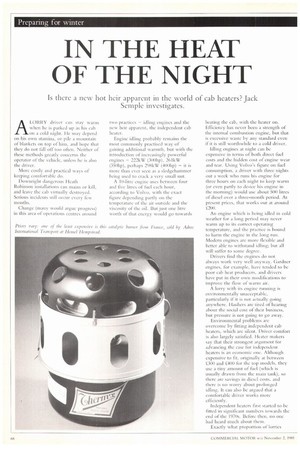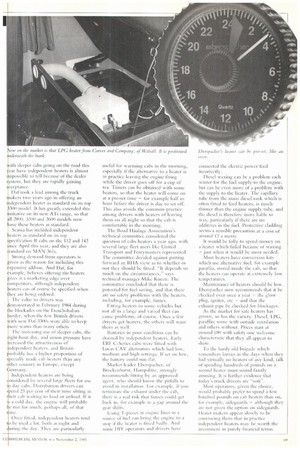IN THE HEAT OF THE NIGHT
Page 70

Page 71

If you've noticed an error in this article please click here to report it so we can fix it.
Is there a new hot heir apparent in the world of cab heaters? Jack Semple investigates.
ALORRY driver can stay warm when he is parked up in his cab on a cold night. He may depend On his own stamina, or pile a mountain of blankets on top of him, and hope that they do not fall off too often. Neither of these methods greatly concerns the operator of the vehicle, unless he is also the driver.
More costly and practical ways of keeping condortible do.
Downright dangerous Heath
Robinson installations can maim or kill, and leave the cab virtually destroyed. Serious incidents still occur every 174-2w months.
Change (many would argue progress) in this area of operations centres around
two practices — idling engines and the new heir apparent, the independent cab heater.
Engine idling probably remains the most commonly practised way of gaining additional warmth, hut with the introduction of increasingly powerful engines — 222kW (30Ilhp), 261k W (35(Ihp), perhaps 298kW (400hp) — it is more than ever seen as a sledgehammer being used to crack a very small nut.
A 10-litre engine uses between four and five litres of fuel each hour, according to Volvo, with the exact figure depending partly on the temperature of the air outside and the viscosity of the oil. But just one litre worth of that energy would go towards
heating the cab, with the heater on. Efficiency has never been a strength of the internal combustion engine, hut that is excessive waste by any standard even if it is still worthwhile to a cold driver.
Idling engines at night can be expensive in terms of both direct fuel costs and the hidden cost of engine wear and tear. Using Volvo's figure On fuel consumption, a driver with three nights out a week who runs his engine for three hours on each night to keep warm (or even partly to de-ice his engine in the morning) would use about SIN) litres of diesel over a three-month period. At present prices, that works out at around POI].
An engine which is being idled in cold weather for a long period may never warm up to its correct operating temperature, and the practice is hound to harm the engine in the long run. Modern engines are more flexible and better able to withstand idling; hut all will suffer to some degree.
Drivers find the engines do not always work very well anyway. Gardner engines, for example, have tended to be poor cab heat producers, and drivers have put in their own modifications to improve the flow of warm air.
A lorry with its engine running is environmentally unacceptable, particularly if it is not actually going anywhere. Hauliers arc tired of hearing about the social cost of their business, but pressure is not going to go away.
Environmental problems are overcome by fitting independent cab heaters, which are silent. Driver comfort is also largely satisfied. Heater makers say that their strongest argument for advancing the case for independent heaters is an economic one. Although expensive to fit, originally at between 000 and -'.400 for the top models, they use a tiny amount of firel (which is usually drawn from the main tank), so there are savings in diesel costs, and there is no worry about prolonged idling. It can also be argued that a comfortable driver works more efficiently.
Independent heaters first started to be fitted in significant nuinberti towards the end of the 1970s. Before then, no one had heard much about them.
Exactly what proportion of lorries with sleeper cabs going on the road this year have independent heaters is almost impossible to tell because or the dealer system, but they are rapidly gaining icceptance.
Dal took a lead among the truck makers two years ago in offering an independent heater as standard on its top 3301 model. It has greatly extended this initiative on its new ATi range, so that ill 28(X), 3300 and 3601.1 models now have these heaters as standard.
Scania has included independent heaters as standard on its top specification R cabs on the 112 and 142 since April this year, and they are also standard on MAN 361s.
Strong demand from operators is given as the reason for including this expensive add-on. And Daf, for axample, believes offering the heaters gives it a marketing edge over competitors„iithough independent heaters can of course be specified when tlhey are being ordered.
The value to drivers was
demonstrated in February 1984 during the blockades on the French-Italian border, when the few British drivers with new 1.)at-3311(k were able to keep more warm than many others.
The increasing use of sleeper cabs, the right-hour day, and union pressure have increased the attractiveness of independent heaters, and Britain probably has it higher proportion of specially made cab heaters than any 9ther country in Europe, except Germany.
Independent heaters are being considered by several large fleets for use in day cabs. Distribution drivers can spend 25 per cent of their time sitting in their cab waiting to load or unload. If it a cold day, the engine will probably be run for much, perhaps all, of t I me.
Once fitted, independent heaters tend he used a lot, both at night and uring the day. They arc particularly useful for warming cabs in the morning, especially if the alternative to a heater is in practice leaving the engine firing while the driver goes off for a cup of tea. Timers can he obtained with sonic heaters, so that the heater will conic on at a pre-set time — for example half an hour before the driver is due to set Ofr. "l'his also avoids the common practice among drivers with heaters of leaving them on all night so that the cab is comfortable in the morning.
The Road Haulage Association's technical committee considered the question of cabs beaters a year ago, with several large fleet users like United Transport and Ferrymasters represented. The committee decided against putting forward an RHA view as to whether or not they should be fitted. "It depends so much on the circumstances," says technical manager Mike Kneen. The committee concluded that there is potential tbr fuel saving, and that there are no safety problems with the heaters. including, for example, fumes.
Fitting heaters to some vehicles but not all in a large and varied fleet can cause problems, of course. Once a few drivers get heaters, the others will want them as well.
liatteriCS in poor condition can be drained by independent heaters. Early ER} C-Series cabs were fitted with Lucas CA'V alternators which had low, medium and high settings. If set on low, the battery could run flat.
Market leader Eberspacher, of Brockenhurst. I lampshire, strongly recommends fitting by an approved agent, who should know the pittAls to avoid in installation. For eNampie, if you terminate the exhaust under the cab, there is a real risk that fumes could get back in, for example in a gap around the gear shifts.
Using 'I'-pieces in engine lines as a source of fuel can bring the engine to a stop if the hearer is fitted badly, And sonic DIY operators and drivers have
connected the electric power feed incorrectly.
Diesel waxing can be a problem each winter for the fuel supply to the engine, hut can be even more of a problem with the supply to the heater. The capillary tube from the main diesel tank which is often fitted to feed heaters, is much thinner than the engine supply tube, and the diesel is therefore more liable to wax, particularly if there are no additives in the fuel. Protective cladding seems a sensible precaution at a cost of around til a metre.
It would be folly to spend money on a heater which failed because of waxing — just when it would be most needed.
Most heaters have conversion kits which use alternative fuel, for example • paraffin, Stored inside the cab, so that the heaters can operate at extremely low. temperatures.
Maintenance of heaters should be low. Eberspacher now recommends that it be checked over once a year — the glow plug, igniter, etc — and that the exhaust pipe be checked for blockages.
As the market for safe heaters has grown, so has the variety. Diesel, LPG, paraffin; sonic with outside ventilation and others without. Prices start at around i28(1 with safety one welcome characteristic that they all appear to share.
To the hardy old brigade which remembers lorries in the days when they had virtually no heaters of any kind, talk of spending hundreds of pounds on a second heater must sound faintly amusing. It is further evidence that today's truck drivers are "soft".
Most operators. given the choice, would probably pri.ier to spend a few hundred pounds on cab heaters than on, for example, sideguards — although they are not given the option on sideguards. fearer makers appear slowly to be convincing them that in practice independent heaters may be worth the investment in purely financial terms.












































































































